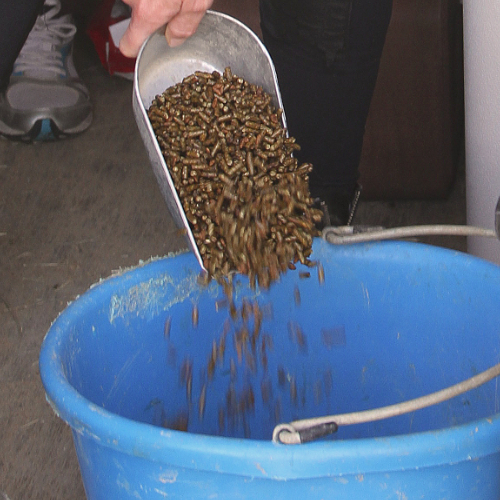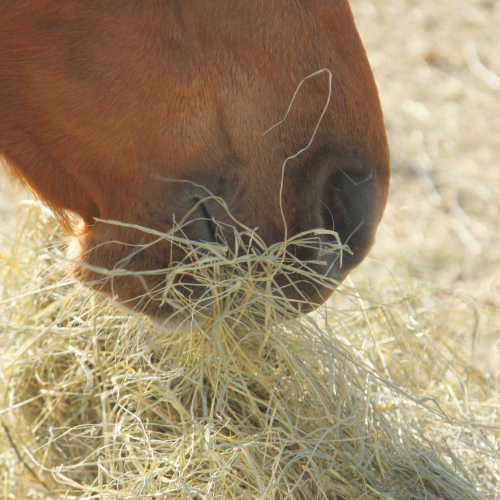By Dr. Lydia F. Gray, posted September 2022
This is the fourth and final article in the Laminitis series. To get the most out of it, we suggest reading the first three articles before tackling this one:
“What is Laminitis in Horses?”
“Laminitis Has More Than One Cause”
“What do Sugars and Starches Have to do with Laminitis?”
For a horse prone to or that has already had a bout of metabolic laminitis, step one is working with a veterinarian to come up with a complete plan for that individual. Proper diet, controlled exercise, plenty of turnout, and other management “best practices” should all be discussed. At the same time, owners should make sure they know how to evaluate Body Condition Score, Cresty Neck Score, and body weight.
Note that horses having an acute laminitic episode may be put on a stricter diet temporarily Exercise may also have to wait. Recovered and at-risk horses can usually be put on a less strict maintenance diet and begin a controlled workout program right away.
Often the first recommendation for reducing sugars and starches in the diet is to remove grain. This means no cereal grain (oats, corn, wheat, barley), no fortified grain in a bag, and no senior or complete feed, especially if it has molasses in it. Replace the protein, minerals, and vitamins with either a low sugar/starch ration balancer or a multi-vitamin paired with an amino acid supplement.

Another source of unnecessary sugars and starches is treats. Sugar cubes and peppermints are off-limits. Other treats –such as carrots and apples - should be given in moderation. Only commercial treats with guaranteed low levels of starch and sugar are appropriate. Hint: if molasses, corn, dextrose, or maltodextrin are listed on the label, chances are it’s not a low NSC product.
Focus on Forage
As important as reducing or removing grain and treats is, forage makes up the largest portion of a horse’s diet so efforts should focus on making hay and grass as safe as possible. Unfortunately, there is no safe pasture in acute laminitis situations, so horses with current sore feet need to be in a dry lot or otherwise restricted from fresh grass. Recovered and at-risk horses may be able to enjoy pasture under certain conditions: early morning, in the shade, with a muzzle. Grass that is stressed from cold temps overnight, drought, overgrazing, poor soil conditions, and other factors should not be grazed by horses prone to laminitis. Young growths of grass are particularly dangerous so spring grazing should be monitored carefully or better yet, omitted altogether.
Since hay will make up all or almost all of the diet for “carbohydrate-intolerant horses,” it’s important to understand the advice and the options for selecting and feeding hay. Most experts recommend feeding 1.5-2% of the horse’s body weight in grass hay. This works out to 15 to 20 pounds of hay spread out over the course of a day for a 1,000 pound horse. In addition, the hay should be less than 10-12% NSC when analyzed by a lab.

NSC stands for Non-Structural Carbohydrates and is a popular term among vets, nutritionists, farriers, and horse owners. However, it’s one of those terms that’s not quite used 100% accurately.
To set the record straight, here are the facts:
Another name for sugars in hay is ESC or Ethanol-Soluble Carbohydrates.
The combination of sugars (ESC) and fructans (a specific type of sugar), is called WSC or Water-Soluble Carbohydrates.
When you combine WSC with fructans, you get NSC, or Non-Structural Carbohydrates .
However, fructans are unlikely to cause laminitis, so we only really need to talk about the sugars and starches in hay, or ESC plus starch.
Unfortunately, neither “ESC plus starch” and “sugars and starches” roll off the tongue like “NSC,” which is probably why “NSC” stuck as the preferred term.
Here’s the problem: hay that would be perfectly fine for a carbohydrate-intolerant horse is labeled “unsafe” because the NSC % is used as a threshold and not the more correct “ESC plus starch” figures
The sugar and starch levels in hay depend on many factors, such as the species of hay (timothy, orchardgrass, brome, coastal Bermuda, fescue, others), the maturity at cutting, how long it dried in the field before baling, and even the time of day it was cut.
One way to make sure that forage is low sugar/starch at each and every feeding is to buy chopped, cubed, or pelleted hay in a bag with guaranteed maximum levels. While buying bags of forage can be pricey – and may not be available in all parts of the country – it does assure that the diet doesn’t change for horses at high risk of laminitis. This is especially important in the fall when horses with endocrine and metabolic disorders experience seasonal issues.
The best and only way to know how much sugars and starches are in hay is to have it analyzed. If it’s not possible to find hay that is naturally less than 10-12% NSC, one option is to soak the hay in water to reduce the soluble carbohydrates. A team of scientists from the University of Minnesota showed that soaking orchardgrass hay in warm or cold water for 15, 30, or 60 minutes lowered the levels of sugars and starches down into the range recommended for horses with laminitis (Martinson, 2012). This traditionally wet, messy, and labor-intensive process is becoming more reliable and convenient with modern hay soaking units where the soak and drain times can be programmed to prevent over or under soaking.
Series Summary
Laminitis is a serious hoof condition in horses that veterinarians and researchers are learning more about every day. This long-standing term is based on the thinking that inflammation plays a key role in lamina damage. However, the vast majority (90%) of episodes are due to the combination of the hormone insulin, a high sugar and starch diet, and the lack of exercise in horses and ponies whose genes put them at-risk.
With current research linking high blood levels of insulin (hyperinsulinemia) to laminitis, there are now practical ways to help prevent horses from developing this potentially career-ending and life-threatening condition. The sugars and starches can be reduced in the diet by soaking hay, limiting grass, and not feeding grain. In horses that are sound, exercise can be added or increased. A horse or pony’s body condition score, cresty neck score, and body weight can be regularly assessed. And owners can work with their veterinarian to monitor blood insulin and glucose levels as well as the presence of other diseases and conditions that may complicate the situation. Laminitis will probably always be around, but now science has given owners a better understanding of what puts their horses at risk and practical methods to reduce the threat.
